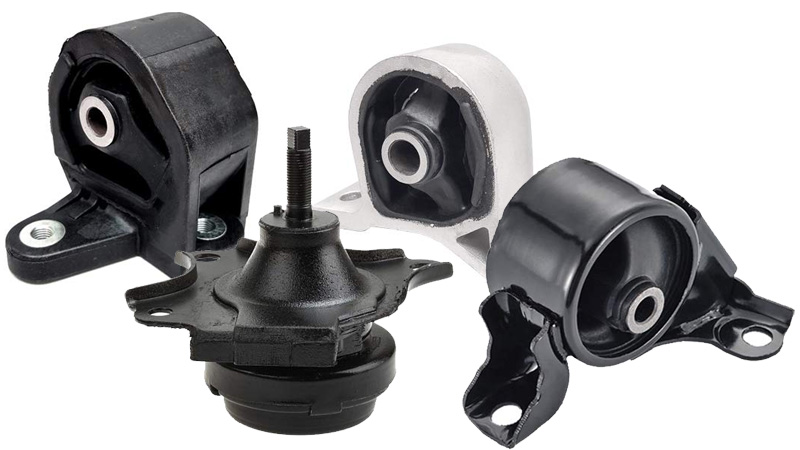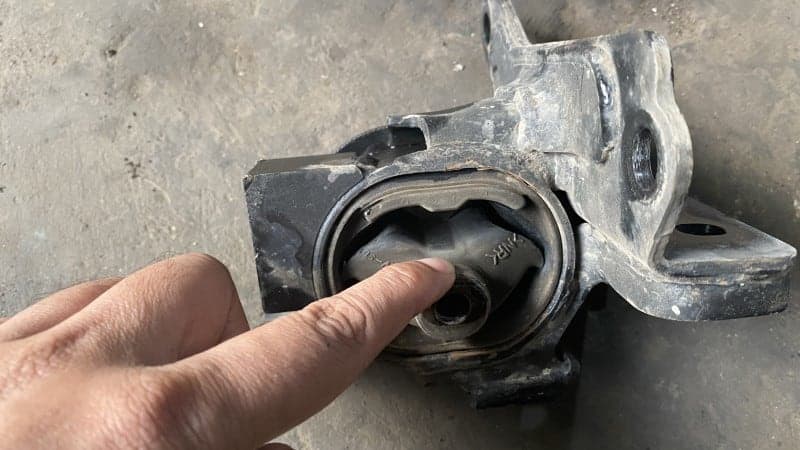Engine mounts play a vital role in insulating the cabin from vibrations and securing the engine firmly in position. Over years of heat, vibration, and strain, these rubber and fluid-filled mounts weaken and deteriorate. Learning the common signs of bad motor mounts will help you diagnose issues promptly and restore smooth driving. This guide covers what to look for and listen for when inspecting engine mounts.
What Are Engine Mounts?

Engine mounts, also known as motor mounts, are components that secure a vehicle’s engine to the chassis or frame while still allowing some movement. They absorb vibrations from the engine and drivetrain to isolate them from reaching the rest of the car. This prevents vibration transfer to the cabin, making for a smoother, quieter ride.
Mounts hold the engine stable within the engine bay while allowing the necessary motion from engine torque and shifting loads. They play a crucial role in engine performance, vehicle handling, noise reduction, and safety. Worn or damaged mounts can negatively impact these areas in your car.
Types of Engine Mounts

There are several different types of engine mounts, each designed to allow various degrees of engine movement while controlling vibration. The most common include:
- Standard Mounts: These economical rubber mounts provide basic engine isolation. They allow more engine motion and transmit greater vibration than other designs.
- Hydraulic Mounts: Contain hydraulic fluid to dampen vibrations. They offer improved vibration isolation compared to standard mounts.
- Active/Electronic Mounts: Utilize sensors and electronic control of hydraulic pressure to optimize vibration damping. They deliver the highest level of isolation.
- Torque Struts: Brace the engine against lateral forces instead of vertical weight. They prevent the engine from excessively rocking side-to-side.
- Solid Mounts: Made from inflexible solid rubber or polyurethane. They offer almost no isolation but provide sturdy support during high-performance driving.
The type of mounts your car uses depends on the vehicle manufacturer, engine design, and other factors like desired handling characteristics. Luxury cars tend to use more sophisticated mounts for greater smoothness, while sports cars may have more solid mounts for responsiveness.
How Do I Know If My Car Engine Mounts Is Bad?

Here are the common signs of bad motor mounts and steps to restore smooth driving after this occurrence.
1. Increased Engine Movement
Defective mounts allow abnormal engine motion and shifting.
- Rocking sensation: Pressing the accelerator may cause the engine to rock and torque against its restraints.
- Excessive vibration: Loose mounting allows the engine to shake more freely, transferring vibrations to the chassis.
- Banging on acceleration: Bad rear mounts let the engine rock back violently when accelerating from a stop.
- Improper engine angle: A collapsed mount tilts the engine outside its normal seated position.
- Contact wear: Loose components may contact each other, causing abnormal noises or damage.
Inspect all mounting locations for sagging, splitting, disconnected or collapsed mounts.
2. Clunking Noises
Another key indicator of bad mounts are new clunks and knocks, especially during shifts:
- Gear changes – As engine torque changes during shifts, the loose engine rocks and knocks against the transmission.
- Acceleration/deceleration – Accelerating or braking shifts inertial forces which clunk against bad mounts.
- Cornering – Body roll during cornering lets the engine torque sideways into a weakened mount.
- Startup – Releasing the starter causes the engine to jump against sagging mounts.
Isolate noises to a particular area and visualize what components are impacting one another.
3. Increased Cabin Vibrations
When mounts no longer dampen vibrations effectively, more shake gets transferred into the cabin:
- Gear engagement – Excessive buzz and vibration is felt in the shifter when shifting into Drive or Reverse.
- Floorboards and pedals – The accelerator pedal, brake pedal and floor pan vibrate more at idle.
- Steering wheel – Extra vibration is sensed through the steering wheel, especially at higher RPMs.
- Seats – Vehicle occupants begin to feel engine rumbling through the seats.
Judge mount condition based on when and where vibrations occur most. For example, right engine mount failure increases vibration on the right side.
4. Exhaust Leaks or Damage
The engine shifting on bad mounts strains and misaligns the exhaust:
- Manifold leaks – Cracks open up in the exhaust manifolds or connection points.
- Pipe leaks – Exhaust pipes bend or separate at the slip joints or hangers.
- Catalytic converter damage – Excess engine movement rocks and cracks the catalytic converter.
- Hanger failure – Strain on piping leads to broken rubber exhaust hangers.
Inspect closely for new exhaust leaks heard or carbon soot trails seen around engine and underbody components.
5. Visual Mount Damage

Physically examine each mount for obvious signs of deterioration:
- Split, torn, or cracked – The rubber will appear sliced, jagged, or peeled away from the metal plate.
- Collapsed – The rubber collapses down with no spring or tension left. The engine rests lower.
- Squished – The mount rubber appears abnormally compressed or flattened out.
- Fluid leaks – Fluid-filled mounts may leak from a ruptured bellows or cracked housing seam.
- Rust and corrosion – This weakens the mount bonding and indicates it may soon detach.
Compare mounts on both sides to determine if one has degraded more than the others have.
6. Acceleration Deficits
As engine torque twists against bad mounts, power transfer to the wheels suffers:
- Hesitation – Loose engines do not hold power effectively, causing hesitation when accelerating.
- Lack of top speed – The engine may fail to generate maximum RPM and top speed when mounts are extremely loose.
- Lack of power – Accelerating from a stop lacks its normal gusto as power bleeds off through the drivetrain.
- Surging: There is a lack of linear power delivery as the engine rocks back under throttle.
Verify mounts are sound if acceleration feels inconsistent and power does not build smoothly.
Why Are Engine Mounts Important?

Properly functioning engine mounts are critical for several reasons:
1. Noise Reduction
Engine mounts reduce the transmission of engine vibrations into the cabin. This keeps your car quieter, so you and passengers don’t have to endure loud rattling or droning noises while driving. Bad mounts allow more vibration through, creating an annoying buzz.
Ride Comfort By absorbing engine movements, mounts create a smoother, more comfortable ride. You’ll feel less engine vibration coming through the steering wheel, seat, and floor. Worn mounts let you feel more engine motion, diminishing ride quality.
2. Vehicle Handling
Mounts help keep the engine securely in position to prevent excessive motion. This allows for precise steering and handling. Weak mounts let the engine rock and move more, potentially impacting control around corners.
3. Performance
Solid mounts in performance applications improve response by stiffening the chassis and engine connection. But for typical driving, softer mounts are preferred for smoothness, comfort, and isolation.
4. Collision Safety
In an accident, properly mounted engines are less likely to break free and enter the cabin. Weak mounts increase the chance of dangerous engine displacement.
Can I Drive With a Bad Engine Mount?
Yes, you can technically drive with one bad engine mount in the short term. The engine will still run, and the car will operate. However, this is not recommended, for several reasons:
- Increased vibration, noise, and loss of ride comfort
- Possible impact on vehicle handling and control
- Greater chance of mount failure and severe engine movement
- Potential for damage to mounts, engines, transmission, and chassis
One failed mount puts more strain on the remaining mounts. The excessive motion can then quickly degrade the other mounts, snowballing into a larger problem. Even one bad mount needs to be addressed immediately to avoid bigger issues down the road.
How Much Does It Cost to Replace Engine Mounts?

Engine mount replacement cost depends on the car, number of mounts, parts prices, and labor rate. Average costs can range from $150 to $600 for basic mount repairs. More extensive jobs replacing multiple mounts on luxury or performance vehicles can exceed $1000.
Here are some ballpark mount replacement costs:
- 1-2 rubber mounts on basic vehicles: $150-300
- All mounts on a family sedan – $400-700
- Multiple mounts on a luxury/performance car – $700-1200+
Shop around between mechanics to find the best labor rate. Also consider buying and installing aftermarket performance mounts yourself to save on parts and labor.
Steps to Replace Engine Mounts

Replacing bad engine mounts restores smooth driving and protects your car. Here is a simplified overview of the process:
- Raise and secure the vehicle; the engine bay needs clear access.
- Support the engine using a jack or homemade wood cradle to prevent sudden dropping.
- Locate the mounts; consult a repair manual for your car’s positions.
- Disconnect mount hardware; remove bolts and nuts securing the mount to the engine and frame.
- Remove the old mount and pry it out using large screwdrivers or pry bars.
- Clean mounting surfaces; remove all debris and old adhesive residue.
- Install a new mount and make sure mating surfaces align correctly.
- Reinstall bolts; tighten bolts and nuts to factory torque specs.
- Remove engine support and lower the jack or cradle once all mounts are secure.
- Lower the vehicle, remove supports, and test drive.
Some steps may vary for different mount types. Having a shop replace your mounts is recommended unless you’re very DIY-adept. Proper procedure is key to preventing engine misalignment or damage.
Wrapping Up
Watching for signs of mount wear and addressing issues early provides the best odds of avoiding damage to other components. Take note of new vibrations and noises and inspect mounts periodically to maximize their working life. Properly mounting your engine preserves your vehicle’s performance and driving experience.

